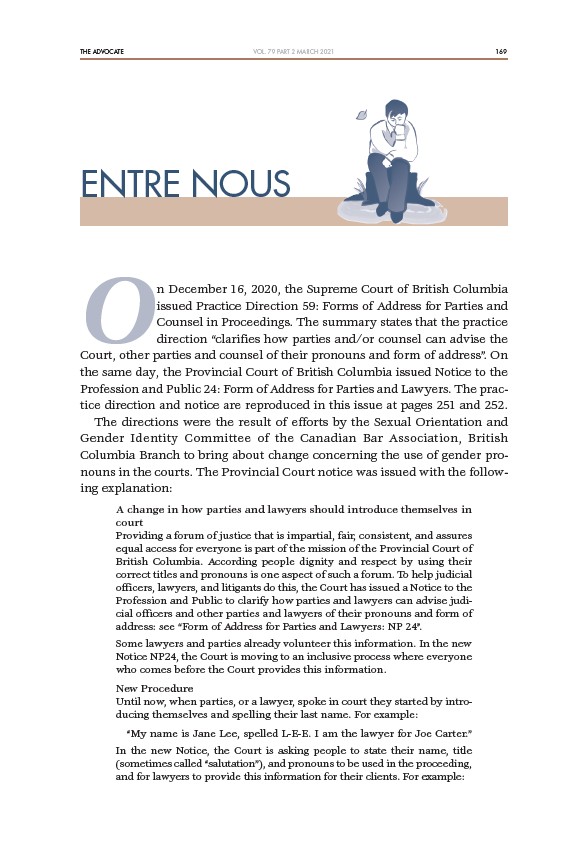
THE ADVOCATE V O L . 7 9 P A R T 2 M A R C H 2 0 2 1 169
ENTRE NOUS
On December 16, 2020, the Supreme Court of British Columbia
issued Practice Direction 59: Forms of Address for Parties and
Counsel in Proceedings. The summary states that the practice
direction “clarifies how parties and/or counsel can advise the
Court, other parties and counsel of their pronouns and form of address”. On
the same day, the Provincial Court of British Columbia issued Notice to the
Profession and Public 24: Form of Address for Parties and Lawyers. The practice
direction and notice are reproduced in this issue at pages 251 and 252.
The directions were the result of efforts by the Sexual Orientation and
Gender Identity Committee of the Canadian Bar Association, British
Columbia Branch to bring about change concerning the use of gender pronouns
in the courts. The Provincial Court notice was issued with the following
explanation:
A change in how parties and lawyers should introduce themselves in
court
Providing a forum of justice that is impartial, fair, consistent, and assures
equal access for everyone is part of the mission of the Provincial Court of
British Columbia. According people dignity and respect by using their
correct titles and pronouns is one aspect of such a forum. To help judicial
officers, lawyers, and litigants do this, the Court has issued a Notice to the
Profession and Public to clarify how parties and lawyers can advise judicial
officers and other parties and lawyers of their pronouns and form of
address: see “Form of Address for Parties and Lawyers: NP 24”.
Some lawyers and parties already volunteer this information. In the new
Notice NP24, the Court is moving to an inclusive process where everyone
who comes before the Court provides this information.
New Procedure
Until now, when parties, or a lawyer, spoke in court they started by introducing
themselves and spelling their last name. For example:
“My name is Jane Lee, spelled L-E-E. I am the lawyer for Joe Carter.”
In the new Notice, the Court is asking people to state their name, title
(sometimes called “salutation”), and pronouns to be used in the proceeding,
and for lawyers to provide this information for their clients. For example: